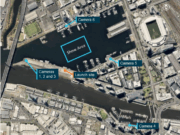A long-range gas-electric drone has completed the first civilian beyond-visual-line-of-sight (BVLOS) flight conducted without observers under rules set forth by the U.S. Federal Aviation Administration (FAA), the drone’s manufacturer says.
Skyfront said Wednesday that the flight by its Perimeter 4 hybrid drone was “a significant step toward the safe integration of unmanned aerial vehicles into the national airspace.”
The company said the Perimeter 4 was flown in accordance with U.S. Federal Aviation Regulations Part 107 rules for the operation of small unmanned aircraft — those weighing less than 55 lb (25 kg). One provision of those rules says that the drones are to be flown within the visual line of sight of the operator or a visual observer.
In this case, the BVLOS flight was approved by the FAA. It was conducted over what was described as mountainous terrain above a 4 mi (6 km) length of the Trans-Alaska pipeline.
The drone “maintained a constant above-ground altitude of 400 feet, with multiple ascents and descents of 1,000 feet on 45-degree slopes,” Skyfront said. “Radio-based telemetry, command and control of the vehicle was uninterrupted during the flight.”
Representatives of the FAA observed all aspects of the mission, beginning with planning for the flight, said Robert Huber, program manager for the FAA Integration Pilot Program, who added that the flight was conducted “safely, effectively and efficiently.”
Skyfront CEO Troy Mestler said the flight was “a milestone in the unmanned community” that pushed the limits” for drone operations in the United States.
Skyfront said that the drone was equipped with a collision avoidance system and observed by ground-based detect-and-avoid systems.
The University of Alaska Fairbanks and the Alaska Center for Unmanned Aircraft Systems Integration purchased the Perimeter 4 and organized the pipeline flight, with approval from the Alyeska Pipeline Service Co., Skyfront said.


